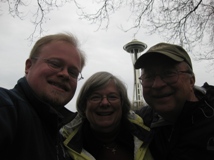What makes up a comet?
Mike Zolensky (left), Stardust curator and co-investigator, and Donald Brownlee, principal investigator with the University of Washington, study Stardust material after its canister is opened in a laboratory at the Johnson Space Center. Image credit: NASA
Project Stardust aims to answer that question. This mission, which launched nearly seven years ago, has finally returned to Earth after completing its mission to capture cometary materials.
Scientists have confirmed that particles from a comet and interstellar dust have been returned to Earth by NASA’s Stardust mission. “The collection of cometary particles has exceeded our expectations,” said Dr. Donald Brownlee, Stardust principal investigator from the University of Washington, Seattle. “We were absolutely thrilled to see thousands of impacts on the aerogel.”
Back in my undergrad days in the physics and astronomy programs at the University of Washington, Dr. Browlnee was one of my professors. In the fall of 2000 I took Astro 321: The Solar System from Donald (which was really interesting even though it wasn’t what I was really interested in. The class page has a funny note up right now: “Note: Don has a spacecraft returning to Earth in Janurary and he will miss a few classes- including the first one. Toby Smith will cover the missed classes.” Heh.). One day Donald came into class a bit late and was obviously frazzled and kinda out of it. Being one of the upper level undergrad classes, things were pretty layed back in class so we probed him to find out what exactly was wrong. Turns out they had lost contact with Stardust and it had gone into some powersaving mode and couldn’t bring it out of it or something along those lines. Needless to say he was not very excited. I don’t think we learned too much on that day! Luckilly it turned out to not be a big issue and the rest of the mission went fairly smoothly: last week Stardust came to an end with its capsule containing cometary material landed in a Utah desert.
Closeup view of a cometary impact (center) into aerogel was inspected by scientists at a laboratory at the Johnson Space Center hours after the Stardust Sample Return Canister was delivered to the Johnson Space Center from the spacecraft’s landing site in Utah. Image credit: NASA. Click for larger image.
Now that the material has returned, the processing must begin. The general public can actually help with this in a project called Stardust@Home. When it starts up, you can download images taken through their microscope and search for microscopic dust particles. They estimate that it would take over 20 years of continuous scanning for them to search all the date themselves, that is why they need us! If you are the first to find a particle you will be included in research papers. Pretty cool, eh?
Check out more on the Startdust mission, it is pretty interesting!
Resources:
Stardust Mission
Stardust@Home
Stardust image gallery
Wikipedia - Stardust
Tom’s Astronomy Blog - the landing of the capsule
Cheers!
-Matt Jones




We were wondering if you had Brownlee for a professor. Kind of interesting stuff, huh? Hope this quarter goes well for you!!!
Hugs!
Yeah, he was a very softspoken nice guy, I really enjoyed him as professor. Interesting stuff indeed!
Thanks, I hope it goes well too!